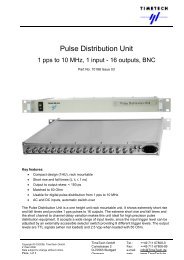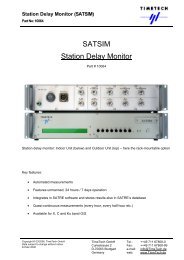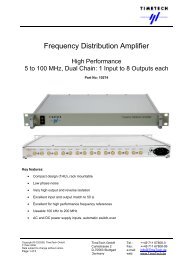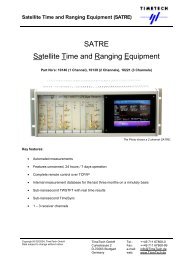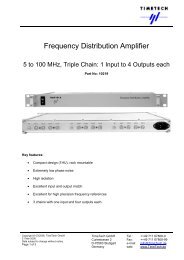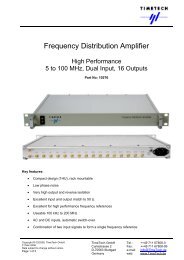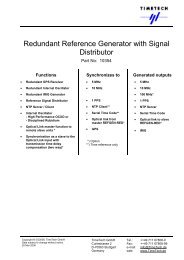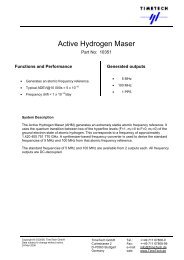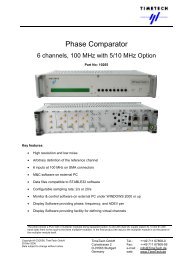Clean-up Oscillator - TimeTech GmbH
Clean-up Oscillator - TimeTech GmbH
Clean-up Oscillator - TimeTech GmbH
You also want an ePaper? Increase the reach of your titles
YUMPU automatically turns print PDFs into web optimized ePapers that Google loves.
<strong>Clean</strong>-<strong>up</strong> <strong>Oscillator</strong><br />
5 / 10 / 100 MHz ultra low phase noise clean-<strong>up</strong> oscillator<br />
Frequency offset and frequency drift compensation<br />
Part No: 10281<br />
<strong>Clean</strong>-<strong>up</strong> <strong>Oscillator</strong> front panel label and acronym in text: CLEAN<br />
Copyright © 04/2006, <strong>TimeTech</strong> <strong>GmbH</strong><br />
Data subject to change without notice.<br />
04 April 2006<br />
Page 2 of 11<br />
<strong>Clean</strong>-<strong>up</strong> <strong>Oscillator</strong> Applications<br />
I Phase noise clean-<strong>up</strong> with 100 MHz generation<br />
-80 dBc/Hz<br />
-100 dBc/Hz<br />
-106 dBc/Hz<br />
Phase noise<br />
Phase noise of 100 MHz generated from input<br />
without the CLEAN function<br />
5 MHz input signal phase noise (example)<br />
Offset frequency<br />
Improved phase<br />
noise output of the<br />
CLEAN<br />
13.10.2005 - PN_cleaning mw<br />
Phase noise over offset frequency, improvement by<br />
internal oscillator performance<br />
II Improving the ADEV stability<br />
5 x 10 -12<br />
1 x 10 -13<br />
ADEV<br />
ADEV improvement potential<br />
13.10.2005 - ADEV_improving mw<br />
Example input signal ADEV performance<br />
CLEAN internal oscillator performance<br />
10 ... 1000 sec<br />
Resulting ADEV performance<br />
of the CLEAN output signal<br />
Short term ADEV over tau, improvement by internal<br />
oscillator performance<br />
Tau<br />
The output frequency of commercial atomic clock<br />
equipment (e.g. Rubidium, Caesium, Hydrogen maser)<br />
is at 5 MHz, 10 MHz, or 100 MHz. Its phase noise is<br />
good, but it can even be improved by the CLEAN.<br />
Especially when generating 100 MHz clock reference<br />
signals (e. g. for reference input to <strong>up</strong>-converters) an<br />
excellent phase noise performance is essential<br />
because improving the phase noise of the reference<br />
signal directly improves the signal to noise ratio of the<br />
generated RF signal.<br />
The CLEAN generates a very low phase noise output<br />
at 100 MHz.<br />
The output frequency stability of commercial atomic<br />
clock equipment is very high in the long term, but in the<br />
short term further improvement is possible. The internal<br />
oscillator of the CLEAN provides enough short term<br />
stability for significantly improving the stability of a<br />
Cesium reference clock. This improves any time<br />
interval measurements <strong>up</strong> to time intervals of several<br />
100 seconds. As the improvement is achieved by the<br />
internal oscillator intrinsic phase stability performance<br />
the improvement factor depends on the stability of the<br />
reference input. Less stable input leads to a higher improvement factor. The time constant of the<br />
internal oscillator control loop can be adjusted for optimising the performance.<br />
III Clock ensemble monitoring<br />
Channel 1<br />
Channel 2<br />
Channel 3<br />
Channel 4<br />
Channel 5<br />
Reference<br />
PCO = Phase Comparator<br />
PCO<br />
PCO<br />
PCO<br />
PCO<br />
PCO<br />
Processor<br />
6<br />
ADEV<br />
- channel X vs. channel Y<br />
or<br />
- channel X vs. mean frequency output,<br />
evaluation in an external PC<br />
26.10.2005 -5Ch_monitor mw<br />
Phase measurement of 5 input channels, ADEV<br />
output for 6 channel combinations<br />
The outputs of a set of atomic clock equipment can be<br />
monitored against each other by means of a 5 channel<br />
phase comparator function of the CLEAN.<br />
The 5 phase comparators measure the phases of 5<br />
input signals versus a reference clock signal. The<br />
processor allows calculation of ADEV performance of<br />
any channel versus any other channel or of any<br />
channel versus the reference input. Normally the<br />
reference is the internal oscillator output, but the<br />
equipment allows for using an external reference as well (if controlling the internal oscillator is not<br />
required).<br />
<strong>TimeTech</strong> <strong>GmbH</strong> Tel.: ++49 711 67808-0<br />
Curiestrasse 2 Fax: ++49 711 67808-99<br />
D-70563 Stuttgart e-mail: info@<strong>TimeTech</strong>.de<br />
Germany web: www.<strong>TimeTech</strong>.de




